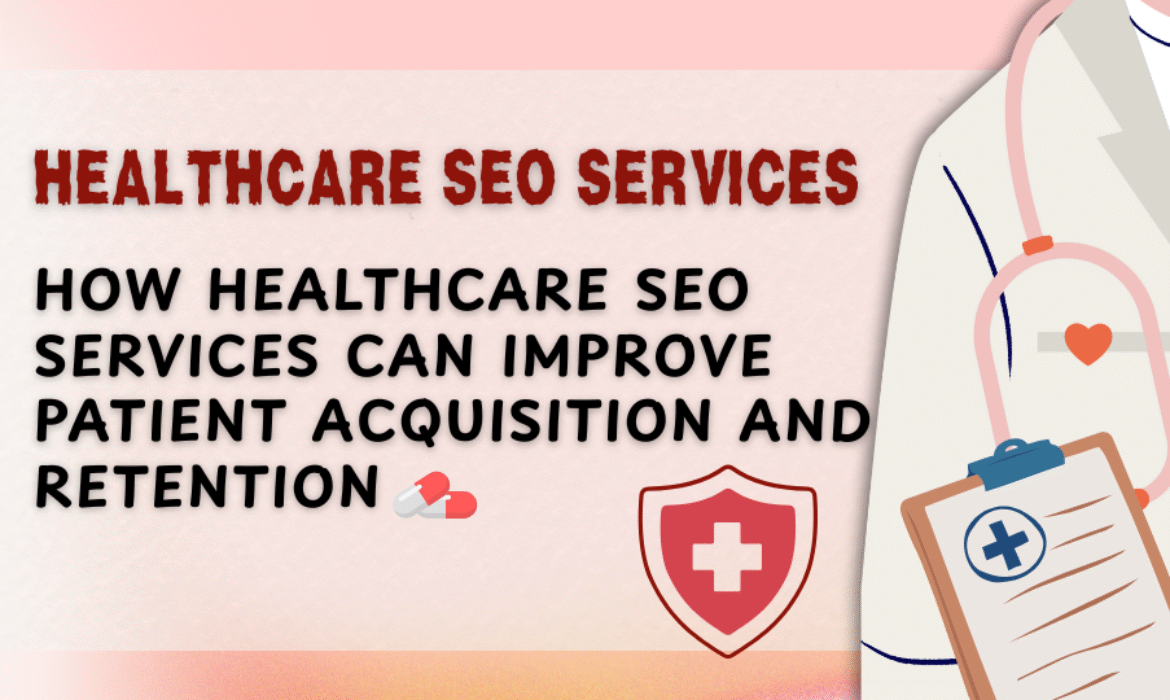In today’s healthcare marketplace, standing out online is not optional—it’s essential. Patients now begin their search for medical services, specialists, and clinics through search engines, directories, and review sites. That means a strong Search Engine Optimization (SEO) strategy designed for healthcare providers can directly drive two critical business goals: acquiring new patients, and retaining existing ones. Below, we explore how healthcare SEO services can support both acquisition and retention, why each matters, and which tactics deliver the best results.
Why acquisition and retention both matter
Patient acquisition refers to attracting individuals who have not previously used your services. It focuses on new patient volume, market growth, and expanding your reach. According to one source, “patient acquisition is the process of attracting new patients to your medical practice” via both online and offline strategies.
Patient retention, on the other hand, is about keeping existing patients engaged, satisfied, and likely to return. Retention strengthens loyalty, increases lifetime value, and often costs less compared to acquisition. One article points out that increasing retention by a small percentage can yield significant profitability, because acquiring new patients tends to be more expensive.
The two work together: You need to acquire patients to grow, but without retention your acquisition efforts lose much of their long‑term value. As one guide puts it: “patient acquisition and retention go hand‑in‑hand” in a strong strategy.
How Healthcare SEO supports patient acquisition
Here are the main ways SEO helps bring new patients to your practice.
1. Improving visibility in search engines
Many patients begin their journey with a query like: “cardiologist in Surat”, “best physiotherapy clinic near me”, or “child specialist hospital in Gujarat”. If your website doesn’t appear near the top of search results, you’re missing the chance to be found. A good medical/healthcare SEO service helps ensure your website ranks higher for relevant keywords and local queries. For example, a blog notes that 72% of internet users search for health‑related information online, making visibility a must.
2. Local SEO & “near me” searches
Especially for clinics or hospitals with a physical presence, local search is critical. Optimizing for local keywords (city, neighbourhood), ensuring your practice is listed in Google Business Profile (formerly Google My Business) with accurate details, and gathering local reviews all help you show up in “map pack” results. If a patient in Surat searches “ENT doctor near me”, you want to rank in the local pack.
3. User‑friendly website and optimized content
A site that loads quickly, is easy to navigate (especially on mobile), and contains high‑quality content signals credibility to both patients and search engines. One SEO guide emphasises website architecture, page speed, intuitive navigation and strong content as part of healthcare SEO. When a potential patient lands on your site and finds it trustworthy and useful, they’re more likely to book.
4. Reputation & review management
Online reviews are a powerful acquisition driver. Patients read reviews to decide which provider to choose. SEO services often include reputation management — encouraging positive reviews, responding to feedback, ensuring your profiles are complete and up to date. A digital‑marketing summary noted that 90% of patients read online reviews before choosing a provider. Positive reviews help your visibility (search engine signals) and build trust, which encourages new patients.
5. Content marketing to target patient intent
Effective SEO is not just technical—it also means publishing content that addresses what patients are searching for: symptoms, treatment options, FAQs, new procedures. This content captures interest and draws patients earlier in their decision path. An article on healthcare marketing lists content marketing as a core strategy for patient acquisition via SEO. If you publish blog posts like “When to see a cardiologist in Surat” or “Signs of pediatric allergy you should not ignore”, you attract users actively looking for care.
6. Tracking and refining via analytics
SEO services for healthcare monitor metrics such as website traffic, keywords ranking, click‑through rates, bounce rates, and conversions (appointment bookings). Using data, you can refine your strategy: which services are popular, what search queries bring traffic, what content converts. This continuous optimisation keeps the acquisition funnel effective.
How Healthcare SEO supports patient retention
Once you’ve attracted patients, it’s crucial to keep them engaged. Here’s how SEO helps retention.
1. Strengthening trust and authority
Retention is built on trust. A website that ranks well, has strong content, displays patient testimonials and provides clear information helps patients feel confident in returning and recommending you. As one guide says: “trust is the cornerstone of patient retention.” Good SEO reinforces that sense of credibility through consistent online presence.
2. Ongoing content and engagement
Retention is not just about the first visit. Using SEO‑driven content—blog updates, newsletter sign‑ups, FAQ pages, patient education materials—you keep your practice top of mind. Patients may return to your site for follow‑up information or book additional services because they see you as a helpful resource, not just one‑time visit. This nurtures the relationship.
3. Better patient experience via website and mobile optimisation
Patients appreciate smooth, convenient digital experiences (appointment booking online, access to information, contact forms, virtual consults). SEO efforts that make your site mobile‑friendly, fast, and logically structured also improve patient satisfaction. A better user experience means more satisfied patients and fewer drop‑offs.
4. Review‑driven loyalty and referrals
Existing patients who feel valued and have good experiences may leave positive reviews and refer others. SEO & online reputation management make that easier. As one article noted, satisfied patients are more likely to recommend your services, which in turn aids both retention and new acquisition.
5. Reducing switching by staying connected
When patients have abundant choices, it’s easier for them to switch providers. A practice with visible, up‑to‑date web presence, strong content, and ease of engagement (online forms, content, reminders) stays in the patient’s mind. SEO helps maintain that connection. Retention strategies often benefit from strong SEO foundations: your website remains active, authoritative, and part of a patient’s journey.
6. Cost efficiency and lifetime value
Since acquisition is more expensive than retention, retaining patients becomes a cost‑efficient way to maximise ROI. The same source mentions retention is more profitable because you avoid acquisition costs. SEO investments that improve retention can thus be very cost wise.
Key components of an effective Healthcare SEO service
If you are evaluating SEO for your healthcare practice (clinic, hospital, speciality centre), the following components should form part of the service:
- Keyword research with healthcare intent: Identify what patients search (symptoms + location, procedure questions, specialist queries) and target those keywords.
- On‐page optimisation: Title tags, meta descriptions, headings, images ALT tags, schema markup (especially healthcare schema) to help search engines understand your content and services.
- Local SEO: Accurate name, address, phone (NAP) across directories; optimised Google Business Profile; local citations; “near me” and geo‑targeted keywords.
- Mobile optimisation & site speed: Ensure mobile responsiveness, fast loading, clean architecture. These factors affect ranking and retention.
- Content marketing & user‑centric content: Create blog posts, FAQs, service pages, patient education materials that answer common queries, differentiate your practice and build authority.
- Reputation management & review monitoring: Encourage and manage patient reviews, respond to feedback, use positive testimonials. This supports both acquisition and retention.
- Analytics & continuous improvement: Monitor traffic, conversions, patient behaviours; refine keywords, content, UX based on data.
- Link building & authority enhancement: Secure high‑quality backlinks (from medical associations, local health organisations) which boost domain authority.
- Compliance and E‑E‑A‑T (Experience, Expertise, Authoritativeness, Trustworthiness): Healthcare content especially must reflect expertise and trust (doctor credentials, accurate information) because search engines treat health content more carefully.
Real‑world impact: How this plays out
Imagine a specialty clinic for orthopaedics in Surat. Without SEO, a patient in the city searching “knee replacement surgeon in Surat” may only find large national hospital chains. With a localised SEO strategy, this clinic appears in the first page, shows patient testimonials, lists services clearly, and has a well‑maintained Google Business Profile with reviews. That improves the chance of the patient contacting them rather than a competitor.
Once the patient becomes a client, SEO‑based retention strategies mean the website offers follow‑up content such as “recovering from knee replacement: what to expect”, “physical therapy timelines”, and regular email or newsletter updates. The patient sees value beyond the appointment and is more likely to return for check‑ups or refer others.
According to one article: “online discovery … when patients seeking healthcare services go online, hospitals and clinics that rank high on a search engine results page are at an advantage.” And yet: “Increasing customer retention by five percent can translate to up to 95 percent greater profitability in the retail world” (and while healthcare is different, the principle holds: retention is powerful).
Common pitfalls to avoid
- Ignoring local SEO: Many practices treat the website globally but neglect “near me” optimisation, category listings, local citations—leading to missed local traffic.
- Poor website experience: Slow load time, not mobile‑friendly, unclear navigation—these drive users away, hurting both acquisition and retention.
- No ongoing content strategy: Building a site and forgetting it won’t cut it. Patients look for updated information, fresh content, voices they can trust.
- Neglecting reputation & reviews: Negative or missing reviews without response impact credibility and search rankings.
- Measuring only traffic, not conversions: Visitors don’t always convert to appointments. Tracking leads and bookings is crucial.
- Thinking SEO is one‑time: SEO is continuous; search trends, algorithms, patient behaviour change. Regular updates are needed.
- Overlooking retention in favour of acquisition: Focusing only on new patients while existing ones slip away reduces lifetime patient value and increases cost per patient.
Making a roadmap: Steps to get started
- Audit your current online presence: Check your website ranking, site speed, mobile UX, Google Business Profile, review volume.
- Define your ideal patient persona: Who are your target patients? What questions do they ask? What keywords might they use?
- Perform keyword research specific to your location and services: Include long‑tail, question‑based queries (e.g., “acl tear treatment options in Gujarat”).
- Optimise your website: Titles, meta descriptions, headings, service pages, testimonials, mobile responsiveness, site speed.
- Create content aligned with patient intent: Blogs, FAQs, videos, downloadable guides that answer common questions and demonstrate your expertise.
- Build your local reputation: Ensure NAP consistency, manage your Google Business Profile, solicit reviews, respond to feedback.
- Track metrics: Traffic, keywords ranking, online appointment bookings, bounce rate, review volumes. Use data to refine strategy.
- Engage existing patients: Use your website and content to keep current patients informed, engaged, and coming back.
- Allocate budget and timeline: Recognise SEO is medium‑/long‑term. Results often improve over months—not overnight.
- Stay compliant and authoritative: Especially in healthcare, ensure your content is accurate, up‑to‑date, includes providers’ credentials, avoids misleading claims.
Conclusion
Healthcare SEO services do more than boost website traffic. They build visibility where patients are already looking, establish trust in what you offer, and keep your practice top‑of‑mind long after a first visit. When done right, SEO becomes a driver of both patient acquisition and retention—two sides of the same sustainable growth strategy.
In a competitive environment where patients have many choices and decisions often begin with a quick Google search, a well‑executed SEO strategy gives your practice the edge. It helps you be found, be trusted, and be chosen. And once a patient chooses you, it helps you keep them.
If you’re looking to grow your practice, consider partnering with a specialised healthcare SEO provider that understands both search engine mechanics and the unique demands of healthcare marketing (regulation, reputation, trust). The right approach will deliver new patients and ensure your existing patient base remains engaged and loyal.






